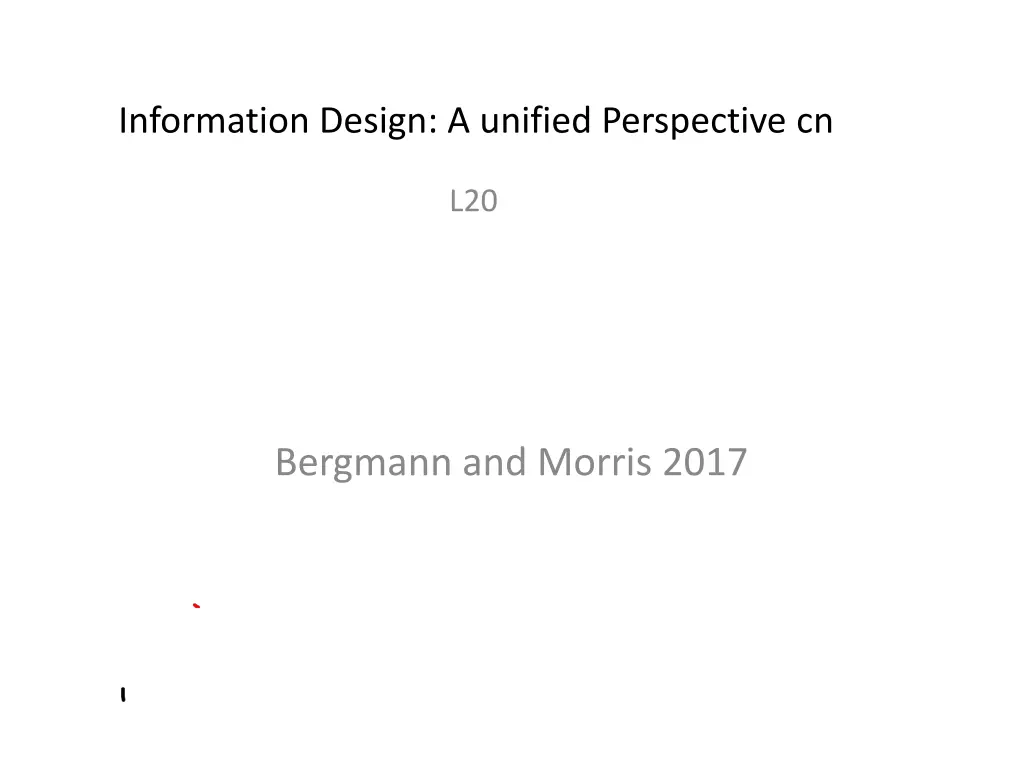
Unified Perspective on Information Design: Bergmann and Morris 2017 Lecture Insights
Explore key concepts from the lecture series by Bergmann and Morris 2017 on information design, including strategic complementarities, decision rules, and asymmetric priors. Dive into discussions on BCE equilibria, private vs. public signals, and optimal choices in a comprehensive manner.
Download Presentation

Please find below an Image/Link to download the presentation.
The content on the website is provided AS IS for your information and personal use only. It may not be sold, licensed, or shared on other websites without obtaining consent from the author. If you encounter any issues during the download, it is possible that the publisher has removed the file from their server.
You are allowed to download the files provided on this website for personal or commercial use, subject to the condition that they are used lawfully. All files are the property of their respective owners.
The content on the website is provided AS IS for your information and personal use only. It may not be sold, licensed, or shared on other websites without obtaining consent from the author.
E N D
Presentation Transcript
Information Design: A unified Perspective cn L20 Bergmann and Morris 2017
Today Alternative priors (comparative statics) Effect of players private information on - set of BCE equilibria - Optimal choice Strategic complementarities among many players - Set of BCE - Optimal choice - Instrumental preferences over correlations - Private vs public signals
In the previous lecture Basic game of incomplete information Communication rule C Decision rule - Let be a collection of BNE decision rules in game - Let be a collection of BCE decision rules in game Characterization: Implication: design problem equivalent to Two step procedure (linear programming)
KG reconsidered Binary state space , equally likely states One player interpreted (firm) - Binary action space - Payoffs (assume x= 0.55) No ``prior information about a state Designer S observes , commits to message structure Objective: max sum of probabilities of investment: This is KG example (modulo changes in labeling)
Decision rule Decision rule (2 dimensional manifold) BCE decision rules Optimal decision rule
Asymmetric prior Prior distribution: Given , ex ante distribution over states and actions BCE is given by two linear obedience conditions Which of the two ``obedience conditions is binding?
Obedience constraints Condition 1 Condition 2 Threshold
Set of BCE equilibria For For Full information transmission and no information With highly informative prior With lower bound on
Players ``prior information Firm receives signal (type) correct with probability Omniscient designer observes (and hence conditions on) Two independent problems with different ``posterior-priors
Decision rule Supose Signal Signal Integrating out types gives the set of all
Obedience constraints Suppose Signal Signal Integrating out types gives the set of all
Questions BCE set for different precisions of prior signal This comparative statics extends to an example with many players
General lessons Example - More informative initial signal makes obedience constraints tighter - BCE set shrinking with higher q Single agent information structure is an experiment (Blackwell sense) Partial (more informative) orders on set of signals - Blackwell ``sufficiency (statistical) order - Blackwell ``more valuable order - Bergmann and Morris ``more incentive constrained order Equivalence of the thee orders (Bergmann Morris 2013) Bergmann Morris 2016 generalizes this to games with many players - Define ``sufficiency (statistical) order on information structures - Show equivalence with ``more constrained order
Two Firms (Many Players) Objective: sum of investment probabilities for both firms Designer has no intrinsic preferences for correlation If no strategic interactions then optimization firm by firm Firm 1 payoff with strategic complementarities Strategic complements (substitutes) if ( )
Decision rule Decision rule (6 numbers +2 ) Wlog symmetric decision rules (4 numbers, 2 for each state) is the probability that firm invests regardless of the other firm Restriction
Obedience (BCE) constraints Obedience of ``invest recommendation With obedience condition for do not invest is redundant
BCE set Set of all BCE symmetric equilibria (4 dimensional manifold) Given by the following inequalities: Its projections to space is given by The BCE set is monotonic in degree of complementarity Optimal points?
Optimal decision rule (for small ) Observation: Correlations relax obedience constraint State G State B Optimal rule Public signals
Optimal decision rule (for small ) Observation: Correlations. tightens obedience constraint State G Assume State B Optimal rule Private signal
General lessons No intrinsic preference over correlation (sum of probabilities) - Correlation: instrument to relax obedience constraint - Strategic complements (substitutes) positive (negative) correlation - Public vs private signals Papers that use this this mechanism - One sided complementarity Madhavet Perego Taneva 2016 - Two sided complementarity Bergmann and Morris 2016 - Strategic substitutes (Cournot) Bergmann and Morris 2013 Intrinsic motives (objective: at least one firm invests) - Ely 2017 (private signals) - Bergmann Heumann and Morris 2016 - Arieli and Babicenko 2016
